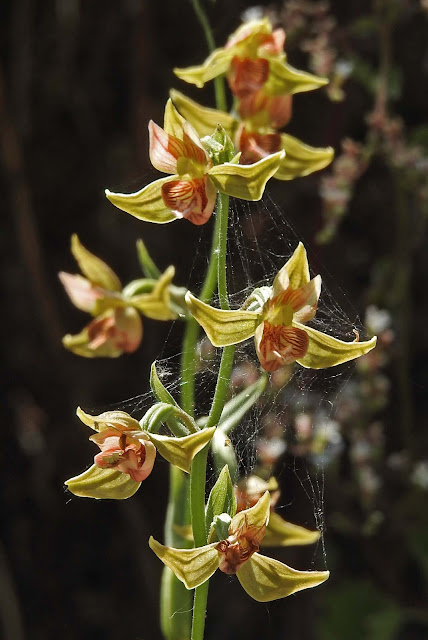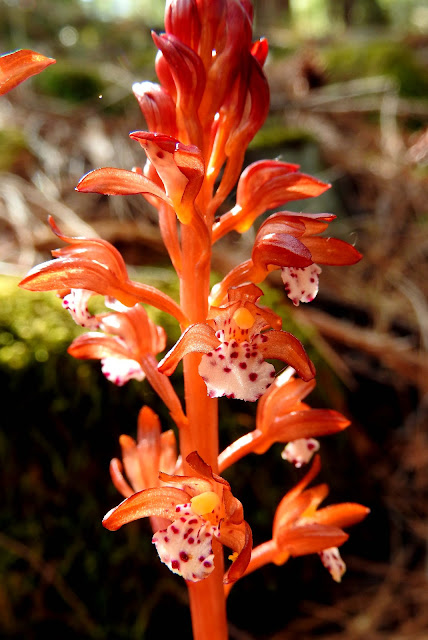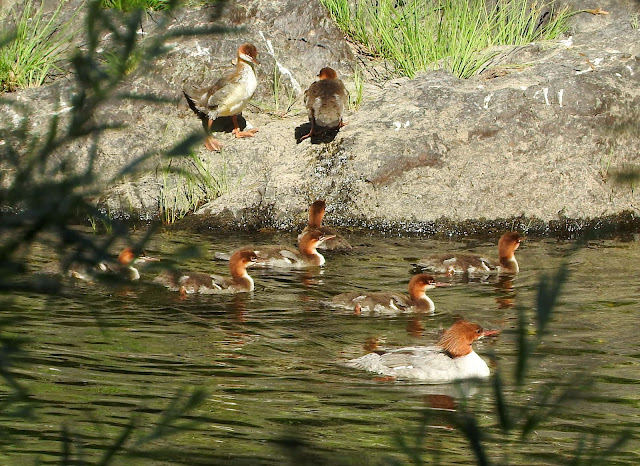Aspen grove in the Lakes Basin Campground - 6/6/25
One rainy afternoon about a month ago, I visited one of my favorite aspen groves up in the Lakes Basin Campground. The trail through the grove was flooded at that time! Now, the trail is totally open and the aspen grove is filled with an astonishing abundance of gorgeous wildflowers in a bright palette of colors! Leopard Lilies are the most numerous, but there are also lots of Monkshoods, Wild Onions, Butterweed, and many other species. Every year it is unbelievably beautiful!
Leopard Lilies - Monkshood
Lilium pardilinum - Aconitum columbianum
Leopard Lilies are frequently, incorrectly named "Tiger Lilies." The word "pardalinum" means "leopard like", as in "spotted". (Tigers are striped not spotted.) Leopard Lilies have lots of dark brown spots on their petals, hence their name. So if you come across an orange lily with brown spots, in a wet meadow or stream side area in California, odds are it is a Leopard Lily!
These elegant lilies can be 2-7' tall, with several hanging flowers on each stalk. Although they are not fragrant, they are gorgeous to look at. These lilies are the most widespread of the wet-growing lilies in our area. They reproduce from rhizomes, or continuously growing, horizontal, underground stems which put out lateral shoots and random roots at intervals.
Leopard Lilies - Arrowhead Butterweed - Monkshood
Lilium pardilinum - Senecio triangularis - Aconitum columbianum
I've posted this photo on my blog before, but I love how it shows the density and variety of wildflowers in the aspen grove! Such beauty!
Monkshood - Aconitum columbianum
All parts of this plant are very toxic and potentially fatal!
So admire it without handling it!
Fireweed - Chamerion angustifolium
Fireweed is one of my favorite wildflowers! These beauties can grow up to 6' tall, with lots of blossoms on each stem. In the Lakes Basin they often grow in dense clusters.
Cow Parsnip - Heracleum maximum
Cow Parsnips can be 3'-10' tall, with lovely, lacey, large umbels.
Swamp Onion - Allium validum
These Swamp Onions can be 1-3' tall. They thrive in wet meadows, and have a distinct onion fragrance.
Sierra Rein Orchid - Plantathera dilitata
Orchids!!!
Over the last few weeks the local orchids have started to bloom! They grow in both low and high elevations. Most of them grow in wet areas, but some grow in the dry forest floor. They are bilaterally symmetrical, with 3 petals and 3 sepals in various arrangements.
There are 8 species of orchids listed in John Muir Laws' book, Laws Field Guide to the Sierra Nevada. I have seen 6 of them so far. Each orchid has a specific insect pollinator, usually a fly, bee, or moth, that is attracted to its scent!
Interestingly the Sierra Rein Orchid (pictured above) is pollinated by moths (at night?) with a proboscis long enough to reach into the nectar spur!
Mountain Piperia Orchid - Dense-flowered Rein Orchid
Piperia transversa - Plantathera elongata
The Mountain Piperia Orchid pictured above, doesn't grow in wet meadows or bogs. Instead, it grows in shady areas of the dry forest floor! The flowers have a clove-like fragrance, which attracts moths.
The Dense-flowered Rein Orchid also grows in the dense, dry forest on very tall (19") stems with lots of tiny, tiny flowers. The flower buds look like little green tadpoles before they open up! The flowers have very long nectar spurs! Moths and butterflies are the key pollinators, but they are also visited by bees.
The Giant Stream Orchid pictured above grows along Highway 49, a few miles past Downieville. There are several colonies of thousands of orchids in this one section of the highway! They reproduce through rhizomes and seeds. They are not usually noticed by motorists, as their coloring is a overall greenish-brown. However, upon close inspection they're gorgeous! The flowers themselves are about 1.5" in length, quite a bit larger than the other local native orchids. They are pollinated by Syrphid Flies, that are attracted to the honeydew scent of the flowers!
Spotted Coralroot Orchid - Corallorhiza maculata
I usually find Spotted Coralroot Orchids growing on the forest floor in shady conifer forests. They don't have any chlorophyll, and are dependent on mycorrhizal fungi (Russula) for nutrients. Sometimes I find clusters of twenty or more plants in one area!
They are primarily pollinated by small bees, wasps, and flies. These insects are attracted to the flowers, likely by their color and scent, and are responsible for transferring pollen between flowers. They also exhibit some degree of self-pollination.
Elephant Heads!
There are two types of Elephant Heads in the Lakes Basin. Elephant Heads (Pedicularis groenlandica) have flowers with long "trunks" and "big ears" and greatly resemble elephants!
Little Elephant's Head - Pedicularis attolens
Little Elephant Heads (Groenlandica attolens) are smaller in size, with trunks that curve up, and ears that hang down! Both species are typically found in wet meadows. So cute!
Common Merganser (adult female and 6 juveniles) - Mergus merganser
Waterfowl Update!
This is the time of the year that you might see female waterfowl and their offspring on our local river and the lakes in the Lakes Basin.
Common Merganser (adult female and 6 juveniles) - Mergus merganser
The two families of Common Mergansers in our neighborhood are doing great! All the ducklings are still with their moms, and are getting closer to their full adult size!
Common Merganser (adult female and 8 juveniles) - Mergus merganser
One of the moms has 6 juveniles. The other mom has 8 juveniles! They will stay with their moms until the Fall.

Mallard (adult female and 6 ducklings) - Anas platyrhynchos
Up in the Lakes Basin we came across two families of Mallards on a large wetland/lake!!! Mallards nest on the ground, and will lay 1-13 eggs per clutch. Only the female hen will incubate and care for the young. The ducklings hatch within 28 days. They are born precocial with downy feathers and open eyes. They usually leave the nest within 24 hours of hatching, and start feeding immediately!! !
Mallard (adult female and 2 juveniles) - Anas platyrhynchos
They will stay with their mother for approximately 52-70 days, until they can fly. During that time the mother will lead them to abundant food sources, issue alarm calls when danger is present, and watch over them. The photos are of two different Mallard hens and their broods. We were so lucky to see these little ones!
What birds are up in the Lakes Basin?
What's happening on the Lakes Basin Lakes?
After 8 years of posting my blog, I've decided that I'm only going to post my blog every TWO weeks from now on. Check back on August 2nd for my next natural history blog.
Your questions and comments are always appreciated! Please email me at northyubanaturalist@gmail.com. Thanks!




.jpg)












.jpg)























